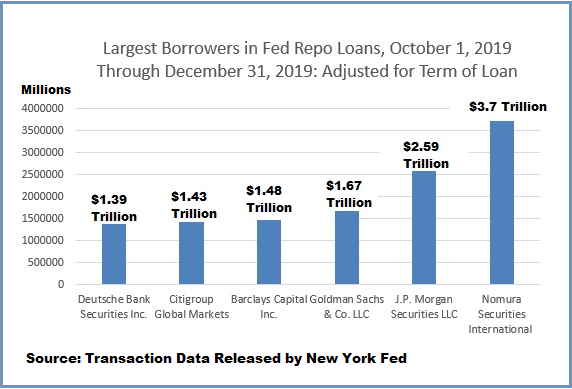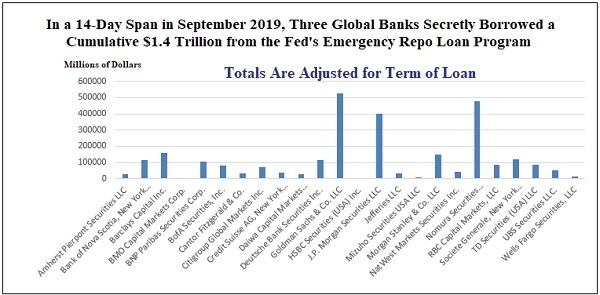by Pam Martens and Russ Martens, Wall St On Parade:

Quietly, on December 1, the New York Fed published the following statement on its website: “The Norinchukin Bank, New York Branch, has been added to the list of Standing Repo Facility Counterparties, effective December 1, 2023.”
The Standing Repo Facility (SRF) is a permanent $500 billion bailout facility created by the Federal Reserve and operated by the New York Fed – the private regional Fed bank where multi-trillion dollar Wall Street bank bailouts have become a regular feature of its operations.
TRUTH LIVES on at https://sgtreport.tv/
Without any action from the U.S. legislative branch (otherwise known as Congress), the Fed has unilaterally decided to become lender of last resort to Wall Street trading houses (whom the Fed prefers to call its “primary dealers”) and deposit-taking banks, including the uninsured New York branches of foreign banks like Norinchukin Bank.
If you have never heard of Norinchukin Bank, don’t feel badly. Neither have we and we’ve been monitoring global banks for decades. According to Norinchukin Bank’s financial statement for its fiscal year ending March 31, 2023, it had $708 billion in assets. If it were a U.S. bank, it would be the fifth largest by assets, just behind JPMorgan Chase, Bank of America, Wells Fargo and Citibank.
The notice from the New York Fed about adding Norinchukin Bank to its bailout facility grabbed our attention for two reasons. First, it came out on a Friday, which is typically when financial entities dump bad news they hope will disappear over the weekend. And also because the Standing Repo Facility was the successor to the trillions of dollars in still unexplained emergency repo loans the Fed had to pump into Wall Street in the fourth quarter of 2019.
As indicated on the chart below, a unit of another Japanese bank, Nomura, was the largest recipient of Fed bailout largesse in the last quarter of 2019. Nomura borrowed $3.7 trillion cumulatively under the Fed’s emergency repo loan program, topping the amount borrowed by JPMorgan Chase by $1.11 trillion. The loan amounts on the chart come directly from the emergency repo loan data released quarterly by the New York Fed, adjusted for the term of the loan. (Reverse repo amounts have to be deleted from the data released by the Fed.)
The Fed swung into emergency mode on September 17, 2019 when the rate on overnight repo loans suddenly spiked from around 2.25 percent to as high as 10 percent at one point, strongly suggesting that Wall Street banks were backing away from questionable borrowers. The Fed set up its own repo facility to make tens of billions of dollars in loans available to trading houses on Wall Street on a daily basis, and at very cheap interest rates that did not reflect the credit risk of the individual trading houses. (Repos, short for Repurchase Agreements, are a short-term form of borrowing where corporations, banks, brokerage firms and hedge funds secure loans, typically for one day, by providing safe forms of collateral such as Treasury notes.) The Fed hadn’t made these emergency repo loans since the financial crisis of 2008.
Instead of making just the typical overnight repo loans in 2019, the New York Fed extended some of these repo loans to 14-day, 28-day, and 42-day term loans, further suggesting some banks were in dire need of long-term liquidity.
The distress being experienced by Nomura likely came from its large derivatives exposure. The fact that JPMorgan Chase and Goldman Sachs were, from the get-go, also borrowing heavily from the Fed, suggests that the three firms were counterparties to each other’s derivatives. (See 14-day chart below beginning when the Fed first launched its emergency repo loan bailouts in September 2019.)
Celebrating 100 years of existence this year, Norinchukin Bank describes itself as a wholesome outfit on its website:
“It is a cooperative private financial institution with a clear mission to ‘contribute to the development of the nation’s economy by supporting the advancement of Japan’s agriculture, fishery and forestry industries by providing financial services for the members of the agricultural, fishery and forestry cooperative system.’ ”
Helping the agricultural, fishery and forestry industries in Japan, unfortunately, has somehow morphed into this:
“Under the policy of reinforcing our asset management business, we transferred our credit and alternative investment functions to Norinchukin Zenkyoren Asset Management (NZAM), an affiliated company of the Bank, in fiscal 2021. In addition, we newly established Norinchukin Capital (NCCAP), for private equity investment and Nochu-JAML Investment Advisors (NJIA), for managing domestic real estate private REITs.
Read More @ WallStOnParade.com





